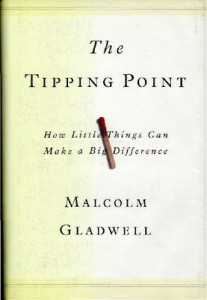After I read ‘Blink’ by the same author, and shared my thoughts with others about it, almost everybody recommended that I read The Tipping Point by the same author. And here are my views about the book and the author’s style of writing.

The Tipping Point by Malcolm Gladwell
I liked the book Blink written by the author more than this one of his. I find Malcolm doing a post-analysis in both of his books. In this book, he analyzes how epidemics spread, and then three rules associated with most epidemics or mass movements. The rules are:
1. There are few people who are responsible for the spreading of epidemics
2. There has to be a stickiness factor in the content
3. And there has to be a relevant context
Now apart from the first rule, are the other two not very logical things? Malcolm tries to drive his points through live examples that have happened in the real world and he tries to take his examples from different worlds so that the book appeals to a wider audience.
Blink spoke about the intuitive powers of people, while this book talks about mass movements. While both books give you insights into some phenomenon, they do not tell you how you can use this information to either create mass movements or improve your intuitive powers. Especially in this book, he puts forth the three rules. But also says that any one or more rules can lead to mass movements.
Updates
A tipping point is “the moment of critical mass, the threshold, the boiling point.” Social epidemics, like the spread of a virus, can be understood by examining three key factors:
- Law of the few: Social epidemics are often driven by a small number of people who are “mavens,” “connectors,” or “salesmen.” Mavens are experts who know a lot about a particular topic and are able to persuade others to adopt their ideas. Connectors are people who know a lot of people and are able to spread ideas through their social networks. Salesmen are people who are skilled at persuading others to buy into their ideas.
- Stickiness factor: The success of a social epidemic also depends on how “sticky” the idea is. A sticky idea is one that is easy to remember, understand, and share. It is also an idea that resonates with people’s emotions or fulfills a need.
- Power of context: The context in which an idea is introduced can also play a role in its success. For example, an idea that is introduced at the right time or in the right place may be more likely to spread than an idea that is introduced at the wrong time or in the wrong place.
There are a variety of case studies to illustrate these three factors. For example, Gladwell discusses the rise of Hush Puppies shoes, the decline of crime in New York City, and the spread of the “6 degrees of separation” idea.
Opinions
The book has been praised for its insights into social epidemics and its ability to make complex ideas accessible to a general audience. However, it has also been criticized for its oversimplification of complex social phenomena.
Overall, it is a thought-provoking book that offers a unique perspective on the spread of ideas and social change.
You may buy this book The Tipping Point: How Little Things Can Make A Big Difference by Malcolm Gladwell at Amazon.
Recommend you read the following reviews of the book by Malcolm Gladwell.








